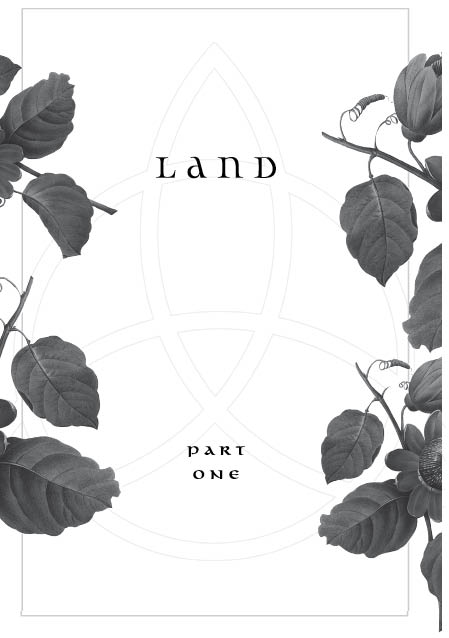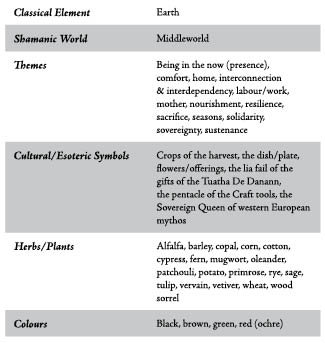By Land, Sky & Sea (3 page)
Read By Land, Sky & Sea Online
Authors: Gede Parma
Tags: #witchcraft, #shamanic witchcraft, #shamanism, #shaman, #celtic, #spirituality, #paganism, #earth-based spirituality, #wicca, #gede parma, #ancient traditions

We have been called the myrk-riders, the hedge witches, the cunning folk, and the medicine men and women. It is because we do not deny the mystery its way (nor could we) that we are therefore the priesthood of the Old Ways, which imbue the individual with power. This is the kind of power that does not require coercion or domination, but rather is pure and wilful intent balanced with spiritual grace and infused with the rhythmic breath of life. Witches are heirs to a great source of power. We call it magick, though others have different names for it—fate, luck, chance, coincidence. It is this force that underlies all things that reminds us of the paradox we honour. Are time and its events preordained by an omnipotent deity, or are all things created by cause and effect? The Witch would say, “No, not all things are set in stone,” and again, “No, we must remember fate,” and then perhaps she would wink slyly and say, “It’s all a memory of something—past, present, future—the spiral of the holy continuum, a blink in the great eye of She Who Is All,” and be done.
So, once again, Witchcraft—as I experience it—is an ecstasy-driven, earth-based mystery path. Ecstasy-driven because we yearn for the Self beyond the self that is, in truth, more than the sum of its parts and equal to it, and we perform rituals harnessing powerful techniques of trance to attain this. Earth-based because without her, who are we? The Earth is the Mother from whom we rose, and it is to her we shall return. We are her rhythm, her cycle; if out of balance, we destroy not only her, but ourselves. We are mysterious because the great mystery is never known beyond that which she gives to behold—and in that glimmer of her is the All, and that is the mystery. We are Witches because inherent in the world is magick, and it flows through us all. Magick doesn’t happen; it
is
.
[
1
]
In Celtic cultures, the otherworld lay beyond the sea, thus its correlation with the ancestors and underworld spirits.
[
2
]
Neo-Wicca is a term that is sometimes used in the Pagan community to distinguish the older Wiccan mystery traditions from the diluted, self-help New Age emphases given in many handbooks today.
[
3
]
This article was first published in Issue 9 of Australia’s
Spellcraft
magazine. It is reprinted here with permission.
[
4
]
Raven Grimassi, in
The Witches’ Craft
(USA: Llewellyn, 2002), cites the historian Jeffrey B. Russell, who gives the Indo-European root
weik
as the etymological ancestor to the word
witch
(
A History of Witchcraft
, Thames and Hudson Ltd., 1980). The word
weik
refers to both religion and magick, in the primal sense of which it was originally used—meaning that if religion was mentioned, magick was implied, and vice versa, as there is no true separation between the two. Russell goes on to state that
weik
gave birth to
wih-l
, which the Old English word
wigle
derives from, meaning “sorcery.”

Correspondences



Live each season as it passes; breathe the air, drink the drink, taste the fruit, and resign yourself to the influences of each.
—Henry David Thoreau
When we are born, we take in our first breath of life, and before we die, we let go of our last. We are sustained by this delicate mixture of oxygen and nitrogen throughout our physical incarnations on this Earth. It is this rhythm of rising and falling, propelled by a beating heart, that our body follows and dances to. The way we breathe can also affect our consciousness, in turn altering our perceptions. It is this secret art of breath control that allows the magickal person to achieve other states and to transform one’s relationship with the energy of life—what I call magick.
The breath of life is not only a metaphor for what we undeniably need, but it is also a story that whispers of impassioned moments of touching the divine heartthrob of the mystery itself. It is not a coincidence that when we are awed by something, our breath catches, and we gasp. For that infinite moment, we are the breath of life—so intimately a part of it that we no longer need to physically breathe (or so I would like to think).
The Latin word for breath is
anima
. Interestingly, anima also means “soul,” and the late psychologist Carl Jung made it one of his nine dominant archetypes when he said that the Anima was the indwelling feminine spirit within a man. Thus, Anima can be seen to be that force of life that sustains us—our soul, our breath, the Mother. This chapter will explore the importance of breathwork in Pagan traditions and the various methods of consciously breathing. Let’s begin.
Conscious Breathwork
The Yogic Breath
In the Eastern art of yoga (and Witchcraft has been called the yoga of the West), one is taught a simple method for conscious breathing. This involves breathing deeply in through the nose and exhaling through the mouth. This technique has come to be called the yogic breath and will form the basis of the breathwork that follows.
The Breath of Light
This technique of conscious breathing utilises the gifts of visualisation. When inhaling, one visualises white light (or another suitable colour like blue or silver) entering the body through the crown, and as the breath is drawn down into the abdomen, the light is seen and felt to pervade every cell, inundating the body with vitality and magick. On the exhalation, smoky, grey energy is seen/felt exiting the body. This visualisation affirms to the individual that all negativity is leaving the body and being transformed by the cosmos so that it can be breathed in again. Always make sure that your breaths are long and deep, so as to instill a peaceful state of being, and do not be afraid to allow the abdomen to expand to its fullest when you breathe in. Embrace the contraction when you exhale. In breathwork, the aim is to be rid of extraneous thoughts. If you are letting thoughts distract you, then you are not properly prepared for your purpose. Remember this when using any method of conscious breathing. However, do not become anxious if your mind becomes riddled with thoughts as you practise your breathing. Simply acknowledge each thought in passing, then let them go.
The breath of light helps to energise the body prior to magickal workings. It is useful before any kind of ritualistic or healing work. You can even adjust the colour of light to suit your magickal intent and purpose—for example, green light for healing and prosperity, or red for passion and love.
The “Ha” Huna Breath
This conscious-breathing method derives from the shamanic Huna traditions of Hawaii. I have been using this technique for several years now, and I find it highly effective in reining in my focus and energising my being for magickal work.
When “ha” breathing, I utilise visualisation just as with the breath of light, except I visualise white light both entering
and
leaving my body. I also see the light of my exhalation circulate to loop back and enter my crown as I breathe in. The “ha” itself is expressed on the exhalation. When breathing out, make a
haaaa
sound aloud (or silently if you prefer). The “ha” itself helps to direct the energy in a focussed manner.
This method of conscious breathing helps to centre, cleanse, and revitalise your aura, as well as align all “selves.”
[1]
The Counting/Square Breath
When I first began making meditation a pointed practice in my spirituality, I referred to Ray Buckland’s “big blue book” (aka
Buckland’s Complete Book of Witchcraft
), and that is where I learnt what I call the counting, or square, breath.
There are many ways to count your breaths. The square method that I employ is broken into four parts. Counting to four slowly, I breathe in; I then hold that breath for four counts. I exhale, counting to four, and then once again hold for four counts. This method can be used to deepen the stillness of the techniques listed above. In general, the counting breath aids in dispelling thoughts and focussing the mind.
These are the four primary breath techniques that I use in my practice. Each one builds on its predecessor, adding detail and definition.
Conscious breathing redirects one’s focus to a state of being that underlies the frenetic comings and goings of mundane reality. It is a simple technique that restores one’s equilibrium and vitality. This is necessary for intense magickal work, as it requires high levels of energy.
Another kind of breathwork that is extremely helpful in developing stillness and peace with the self is the art of observing one’s breath. This is as simple as becoming aware of the way one breathes and watching it for a period of time. However, it must be said that many people in this fast-paced, urbanised world breathe rapidly and shallowly. This can lead to an array of physical health problems, not to mention that these kinds of breaths are not conducive to serious magickal work.
Practice
Find a quiet place and set aside at least half an hour daily for four days in which you can practice each of these methods respectively, building and adding to each one as you go along. On the fourth day, you should be able to meld all four together into one syncretised conscious breath technique. Inhaling through the nose, exhaling through the mouth, visualising a loop of white light as you do so. “Ha” on your exhalation, and remember to count your breaths to beats of four. Soon enough, personalised methods will arise through your continued practice of these four basic techniques.
[
1
]
When I speak of the “selves,” I imply that the wholeness we each are is multidimensional and comprised of various “functional” selves that manifest themselves as layers of consciousness (e.g., the threefold Feri division of the “self” as younger self, talking self, and deep self).
